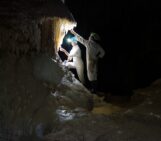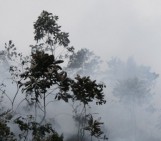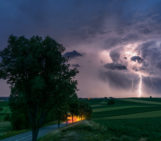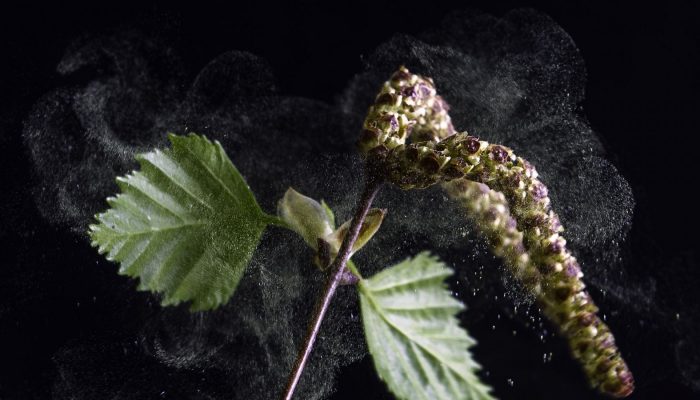
Figuring out what the climate was like, and how it changed, throughout Earth’s history is like trying to complete a 1000 piece puzzle. Except that scientists usually don’t have all the nuggets and building a comprehensive picture relies on a multidisciplinary approach in order to fill in the blanks.
This is particularly true during the Holocene, which spans the last 11,700 years of the Earth’s history, and began at the end of the last ice age. It marks a time of significant climate change across the planet, coupled with changing vegetation dynamics and the emergence of humans, who even at that early time, started leaving their mark on Earth. Bringing together all the evidence to build a complete picture of what the environment looked like is no easy task.
The Mediterranean, in particular, is considered a hot-spot for changing climate and biodiversity in the Holocene. The start of the epoch, in southern Europe, was characterised by a wet climate. The late Holocene, dominated by the presence of humans, is thought to have been warmer and drier. But disentangling the signature of naturally induced change vs. anthropogenically induced change continues to be difficult.
Queue the Maltese archipelago.
A small archipelago in the middle of the Mediterranean Sea
Located in the centre of the Mediterranean basin, approximately 96 km south of Sicily, Malta and a cluster of low-lying islands, including Gozo and Comino, are the focus of a recently published study in the open access journal Climate of the Past.
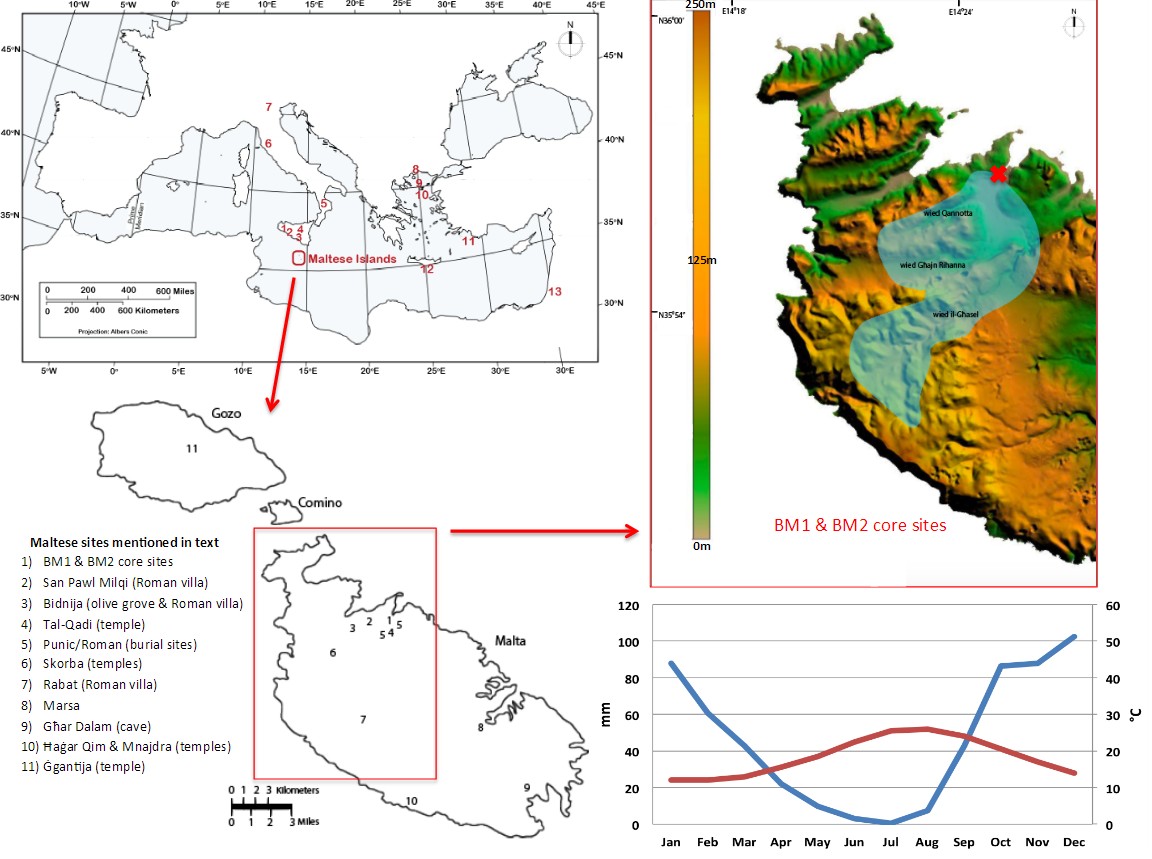
Study area. (a) Mediterranean region highlighting the Maltese Islands. (Selected regional sites mentioned in text of the paper, but not mentioned in this blog post). (b) Maltese Islands. (Key sites mentioned in text of the paper, but not mentioned in this blog post). (c) average annual temperature and rainfall, based on Galdies (2011) data for the 30-year climatic period 1961–1990; (d) the topography and catchment area (blue) of Burmarrad. From B. Gambin et al. (2016). Click to enlarge.
It is their central Mediterranean location that makes the collection of isles so attractive, as they provide a good representation of the overall Mediterranean climate and can help decipher some of the questions regarding southern European climate during the Holocene.
The first human occupants sailed the short distance from Sicily, to settle in the region some 7200 years ago, introducing with them vegetation changes to the area. This well-defined date can be used as a possible marker to distinguish between naturally induced vegetation changes, brought about by climate variations, versus those triggered by the presence of humans.
In the paper, the researchers, led by B. Gambin, also present the first palaeoclimatic reconstruction for the Maltese islands and an updated palaeovegetation reconstruction.
But as encouraging as it sounds, using the Maltese archipelago as a study site for palaeoclimatic reconstructions has one, rather large, limitation. It has no peat bogs or lake deposits, which are the most suitable sites for the collection of data on old vegetation.
Using pollen to reconstruct the story of past climate
The spring and summer months are synonym of the onset of hay fever season for many. But the allergy triggering grains also play a surprisingly important role when it comes to reconstructing past climates, especially when there are no lakes or peat bogs around!
Palynology, the study of pollen grains, has been an important element in piecing together the history of our planet’s past climates since the early 20th Century.
Ancient pollen grains, extracted from sedimentary cores, can contribute to identifying changes in vegetation over time for a given region. If an area’s plant life changes to include more drought resistant varieties, it can point towards a warming climate in that region, whereas propagation of water-loving species might indicate wetter climes. Similarly, a sudden increase (or change) in the presence of pollen from cultivated taxa, like wheat, barely, olives, grapes, etc… highlights the presence of human (anthropogenic) influences in the region.
It is the pollen record, extracted from a core drilled in the region of Burmarrad in Northwest Malta, that the team of scientists used to compile their Maltese palaeoclimatic reconstruction.
Mediterranean climate and key events throughout the late Holocene
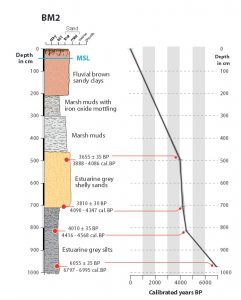
BM2 sedimentary profile and age–depth model interpolated curve. Dates on the core obtained via radiocarbon dating (for method and age detials, please see the paper). From B. Gambin et al. (2016). Click to enlarge.
The 10m long BM2 drill core, extracted using a percussion corer, contained information on the climate, vegetation and precipitation history of the Maltese islands from the early Neolithic period (7280 before present,(BP)) through to the Roman age (1730 BP).
The early Neolothic
Pollen samples collected from the oldest section of the core indicate that from 7280 BP through to 6700 BP the Burmarrad region surrounded an ancient bay (in contrast to the present day agricultural plain setting) with the local vegetation affirming this. The researchers found pollen from non-arboreal (such as herbs and shrubs) taxa, as well as pollen from aquatic and marine species, such as Botryococcus, a common green algae species.
Drill core analysis also highlighted that average temperatures during this period were mild, stable and comparable to present-day values; while winter and summer precipitation levels were relatively high.
The early Neolithic period on the island coincided with the arrival of permanent settlers. But many of the pollen species which usually indicate the onset of anthropogenic influences are also native to Malta making it difficult for the scientists to draw conclusions as to whether the vegetation records show the arrival of the first human inhabitants.
A moister climate from 6700 BP resulted in the spread of Pistacia, a leafy green shrub, across the ancient bay. The damper conditions prevailed across the southern Mediterranean, with increased Pistacia populations found in Sicily and Spain too. The geographically wide-spread nature of the vegetation change indicates it was likely climate driven.
Templar period
By 6050 BP, human settlers started to make their presence felt on the tiny island. Communities started building free-standing stone temples, used for ritual purposes, which are unique to Malta. This settling period is accompanied by the rise in pollen from Olea plants – otherwise known as olive trees – herbaceous taxa such as Brassicaceae (which include mustard plants, radishes and cabbages), and fungus spores which occur in the dung of domestic livestock as well as wild herbivores.
![Ggantija Temples of Malta. Image by Daniel Hausner. Attribution to Norum [GFDL (http://www.gnu.org/copyleft/fdl.html) or CC-BY-SA-3.0 (http://creativecommons.org/licenses/by-sa/3.0/)], via Wikimedia Commons](https://blogs.egu.eu/geolog/files/2016/07/malta_temple.jpg)
Ggantija Temples of Malta. Image by Daniel Hausner. Attribution to Norum [GFDL or CC-BY-SA-3.0], via Wikimedia Commons.
The Bronze Age
The onset of the Bronze Age (4900 to 2650 BP) was marked by a drier climate where winter precipitation decreased and annual temperatures fluctuated between lows of 7°C and highs of 14°C. This coincides with the decrease in abundance of tree pollen found in the BM2 core and an increase in herbaceous taxa (plants which don’t have permanent woody stems).
Microcharcoal horizons become more prevalent in the core too, indicating an increase in fire activity. The drier climate and subsequent vegetation change might be a contributing factor to the increased burning in the region, but it is also likely that slash-and-burn farming was taking hold at this time. Further human activity is indicated by the rise in pollen from plants associated with pastoral activity and the increase in fungus spores commonly found in the dung of livestock.
The strain put on the environment of the Burmarrad Bay at this time is evident by the rise of algal spores and the Glomus fungus, typically associated with increased soil erosion rates. It is further supported by a reduction in overall pollen count in the core, indicating the land could support less plant-life.
The increased erosion rates had a significant impact on the landscape, with the marine lagoon slowly infilling with sediment and eventually becoming landlocked throughout the Bronze Age.
Roman occupation period
By 1972 BP the area became a well-developed fertile deltaic plain, so it’s not surprising that an increase in pollen concentrations from cultivated crop taxa, pointing towards a rise in agricultural activity, were found in the core. The area also benefited from a long period of stable climate with limited temperature and precipitation changes.
During this time, Malta became an important producer and exporter of olive oil, as evidenced by the extensive port-like remains, of this age, found across the island. This is supported by the Olea pollen count in the core, which is high too.
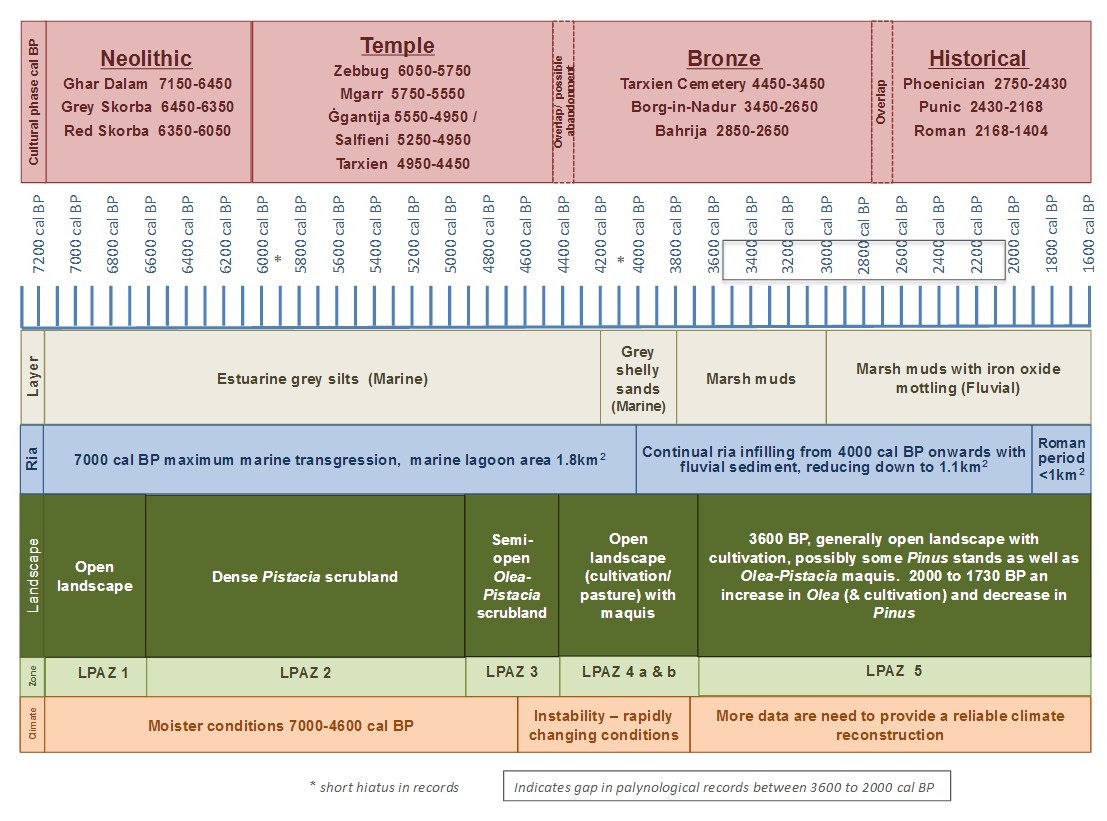
Synthesis of cultural phases, LPAZs (local pollen assemblage zones), sediment, vegetation dynamics, and climatic reconstruction: BM2 core, Malta. From B. Gambin et al. (2016). Click to enlarge.
Climate- vs. human –driven environmental change in the Holocene
The research shows just how powerful palynology is as a tool for reconstructing past climates. The study of the BM2 core allowed scientists to put together a 7300 year history of climatic, vegetation and anthropogenic change in Malta.
At the same time it highlights the ongoing challenge of unravelling the signature of climate- vs. human –driven environmental change in the Holocene.
Taken as a whole, the researchers hope that the findings can be a starting point for further research into this subject, with hopes to gain better understanding of the factors and processes affecting past, present and future Mediterranean landscapes.
By Laura Roberts Artal, EGU Communications Officer
Reference
Gambin, B., Andrieu-Ponel, V., Médail, F., Marriner, N., Peyron, O., Montade, V., Gambin, T., Morhange, C., Belkacem, D., and Djamali, M.: 7300 years of vegetation history and climate for NW Malta: a Holocene perspective, Clim. Past, 12, 273-297, doi:10.5194/cp-12-273-2016, 2016.

